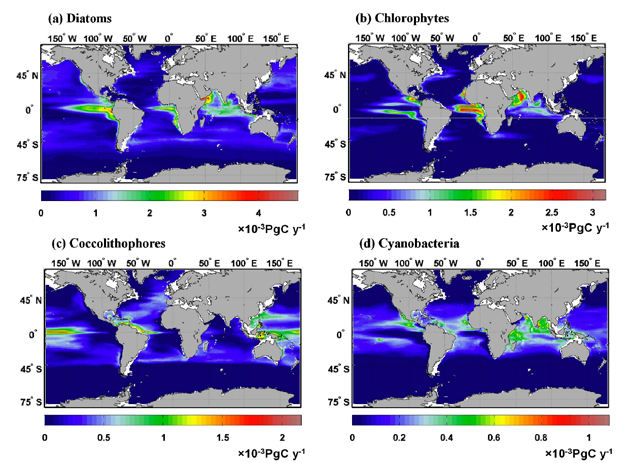Interannual Variation in Phytoplankton Primary Production at a Global Scale
September 2014
Cecile S. Rousseaux, Watson W. Gregg
Phytoplankton, which are microscopic organisms found mainly in the upper layer of the ocean, are the base of the food chain. Through photosynthesis, phytoplankton obtain the energy needed to convert carbon dioxide into organic carbon (the process known as primary production). Phytoplankton are responsible for over half of the net primary production on Earth. This removal of carbon dioxide from the upper ocean is an important factor in climate change, as once removed from its active form, the organic carbon eventually sinks to the deep ocean, where it can stay for an extended period of time. The NASA Ocean Biology Model (NOBM) is a complex computer code developed and used in the Global Modeling and Assimilation Office at NASA Goddard Space Flight Center. Four distinct groupsof phytoplankton are represented in this model: diatoms, cyanobacteria, chlorophytes, and coccolithophores.
Phytoplankton composition plays a major role in the biogeochemical cycle of the oceans. Each phytoplankton group has a different nutrient requirement, growth rate, and sinking rate in the ocean. Most research to date has focused on total chlorophyll, which represents the entire phytoplankton community. The intensity of carbon fixation and export depends strongly on the composition of the phytoplankton community. The contribution of various phytoplankton groups to the total primary production is still poorly understood. It is therefore crucial to quantify the spatial and temporal variability of the group-specific primary production to understand oceanic biogeochemical cycles and how they are likely to respond to climate variability and change.
Rousseaux and Gregg (2014) evaluated the contributions of four phytoplankton groups to the total primary production in the oceans. Their study used the NOBM in a real-world context, which was achieved by including remote-sensing data of ocean color by data assimilation. Globally, diatoms contributed the most to the total phytoplankton production (~50%), followed by coccolithophores and chlorophytes (~20%) and cyanobacteria (10%). Each of these groups has different characteristics, including their growth and sinking rates, which control their spatial and temporal distribution in the model. Primary production by diatoms was highest in the high latitudes (>40°) and in major upwelling systems (Equatorial Pacific and Benguela, system, Figure 1). These upwelling systems, particularly the Equatorial Pacific Ocean, are also known to be strongly influence by climate variability such as El Niño and La Niña.
The study assessed the interannual variability of group-specific primary production over the period from 1998-2011. The work assessed the effects of climate variability on group-specific primary production using global (i.e., Multivariate El Niño Index, MEI) and “regional” climate indices. Most interannual variability occurred in the Equatorial Pacific and was associated with climate variability, as indicated by a significant correlation (p < 0.05) between the MEI and the group-specific primary production from all groups except coccolithophores. This strong correlation between primary production by phytoplankton and climate variability is likely to play an important role in the recruitment of higher trophic levels including fisheries. The collapse of fisheries during the major El Niño event in 1998 was likely linked to the changes in phytoplankton composition and primary production (see Rousseaux and Gregg, 2014).
In the Atlantic, climate variability as indicated by the North Atlantic Oscillation Index was significantly correlated to the primary production of two out of the four phytoplankton groups in the North Central Atlantic (primary production of diatoms and cyanobacteria) and in the North Atlantic (primary production of chlorophytes and coccolithophores). These results provide a data-driven modeling perspective to phytoplankton partitioning of primary production and contribute to our understanding of the dynamics of the carbon cycle in the oceans at a global scale. The continuous improvements of biogeochemical models will ultimately allow for not only prediction, but also sensitivity analyses, which should potentially improve our understanding of the forcing factors of primary production. Since the forcing factors for primary production are likely to be different for each phytoplankton groups, these sensitivity analyses will improve our understanding of the biogeochemical cycles in the oceans.
See Also:
- NASA Video: Phytoplankton Levels Dropping
- The power of three (in International Innovation, Issue 155)
Reference:
Rousseaux, C.S., Gregg, W.W., 2014. Interannual Variation in Phytoplankton Primary Production at A Global Scale. Remote Sensing 6, 1-19. doi:10.3390/rs6010001


